LIGHTNING
egg grader
maker: Lightning, England
sole distributors: Speed Appliances Limited
Selsdon Vale, Selsdon, Surrey, England


the Lightning for grading eggs
| This bakelite egg grader was made by Lightning, England. The egg grader consists of a fixed housing portion and a movable seesaw portion. The egg is placed in the dimple of the seesaw. The seesaw can rotate on two little brass spindles. At the other end of this seesaw a brass stem is screwed. Said stem is placed in the large middle hole of the bakelite house. Left and right thereof, there is also a hole, which is slightly smaller, in which movable up and down hangs a brass part as a weight. These brass parts have a different length and distance to the rocker. When the egg is heavy enough to move the seesaw, the stem moves upwards through the middle hole. With a heavier egg the brass section in the left hole comes up, see the animations below. An even heavier egg forces also the brass part in the third hole at the right upwards. The egg grader is accompanied by an instruction manual with at the front page the text: THE AMAZING SMALLHOLDER EGG GRADER, and with smaller characters the name and address of the sole distributors. On the left inside page is an illustrative drawing and underneath the text: Prov. Pat. this indicates a
| 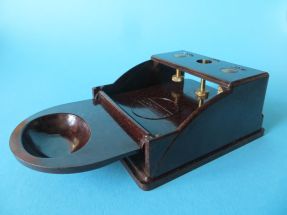
this egg scale sorts in four weight classes
|
provisional patent protection. On the right inside page the egg weight classes and some promotional texts are printed. And also the claim that with this egg grader 1500 to 1800 eggs per hour could be sorted. That's 25 to 30 eggs per minute, or about one egg per every two seconds. This egg grader is intended for small-scale poultry farmers, smallholders, backyarders and other hobbyists. There's also a separate advertising sheet with the fascinating headline: eggs are not potatoes! You yourself naturally read the wonderful sequel text.
With this egg grader eggs are sorted into four weight classes: LARGE (= FIRST) heavier than 2 3/16 oz. (62 grams), STANDARD (= SECOND) between 1 7/8 oz. and 2 3/16 oz.(between 53g and 62g), MEDIUM (= THIRD) between 1 5/8 oz. and 1 7/8 oz. (between 46g and 53g), and SMALL (= no movement of the seesaw) lighter than 1 5/8 oz (less than 43g). The weight classes of eggs by continent and by country changed often over the years. There are also egg graders on which the weight in ounces per dozen is stated on the scale.
A period the lightning was also supplied with an alligator clip that if it was attached according to the drawing -see below- to the seesaw the grader was suited to subdivide small eggs in heavier or lighter than 1½ oz. (more or less than 42,5g).
The bakelite egg scale was also sold with the text: THE "BETTERWAY" PATENT EGG GRADER on the seesaw instead of the brand LIGHTNING. Presumably this is the continuation of the Lightning. At the bottom of the seesaw is put in the bakelite around in an enclosing circle enclosing the text: BETTERWAY ENGLAND, with a capital letter R in the middle of the circle. At the bottom of the house it is expanded with three protrusions with a round hole. On these three holes, the egg grader can be permanently mounted on a table or something like that.The text near the three holes at the top has also been altered, from left to right it now reads: STANDARD, MEDIUM R, SPECIAL. In its leaflet weight classes B = STANDARD be 1 7/8 oz., C = MEDIUM 1 6/8 oz., and A = 3/16 SPECIAL 2 oz. are called in case there is no separate small weight attached on the center stem. In case the small loose weight is attached at the middle stem there are two additional classes D1 and D2. When the center pin raises then the egg is heavier than 2 oz. and belongs to class D1. When the center pin does not rise then the egg weighs less than 2 oz. The metal parts are no longer bras but look to be nickeled steel. In certain versions the center hole has become a slotted hole. In Equilibrium among others a third name is linked to this model egg grader. This egg scale is called ELTEX SMALL EGG GRADER by George H. Elt Ltd, Worcester, England. The brand name ELTEX September 30, 1953 was recorded by George H. Elt Limited. Presumably the ELTEX is the successor of the BETTERWAY. I have not seen any of these egg-scale photographs.
Equilibrium has published extensively about egg scales:
- Egg Scales (Pt.1) by Michael Crawforth, Equilibrium, 1981 No. 4, pp. 375-384;
- Egg Scales (Pt.2) by Michael Crawforth, Equilibrium, 1982 No. 2, pp. 410-417;
- Egg Scales (3) by Michael Crawforth, Equilibrium, 1986 No. 3, pp. 919-924;
- Egg Scales part 4 by Louis Costa, Equilibrium, 1989 No. 4, pp. 1275-1284;
- Egg Scales part 5 by Louis Costa, Equilibrium, 1990 No. 1, pp. 1311-1317.
Much more information is available on the internet.
In the USA nowadays eggs are graded in weight per dozen. They use six weight classes: Jumbo (30 ounces per dozen), Extra Large (27) Large (24) Medium (21) Small (18), and Peewee (15).
Europe usus four weight classes: Extra Large (XL) that is more than 73 grams per egg, Large (X) that is above 63g up to 73g per egg, Medium (M) that is more than 53g up to 63g per egg, and Small (S) that is less than 53g per egg. In the past on German egg scales characters were used, see for example this Ph.J. Maul egg scale. The characters S, A, B, C, and D correspond with the weight classes indicated with different colors, and the scale of this egg scale is also readable in grams.
Below some more pictures of the Lightning egg grader.
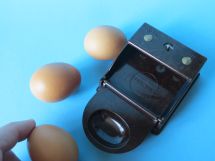
animation: put the egg in the dimple
use your mouse pointer |
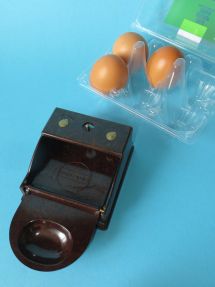
animation: use your mouse pointer to put
an egg on the grader and note the two
rising brass parts |
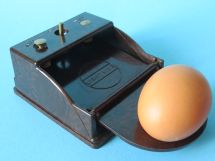
animation: remove the egg from the
grader, use your mouse pointer |
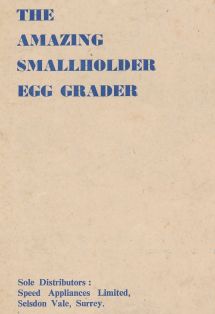
front page instruction manual
|
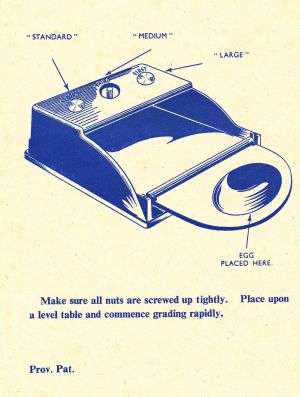
left inside page of instruction manual
|
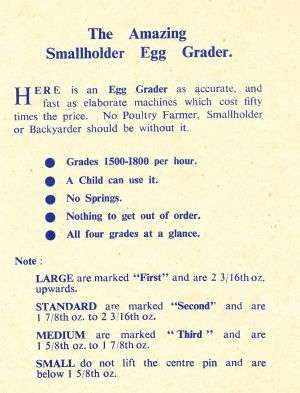
right inside page of instruction manual
|
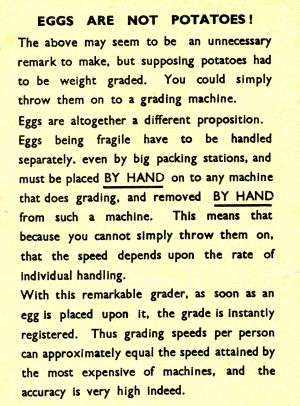
the separate advertising sheet
|
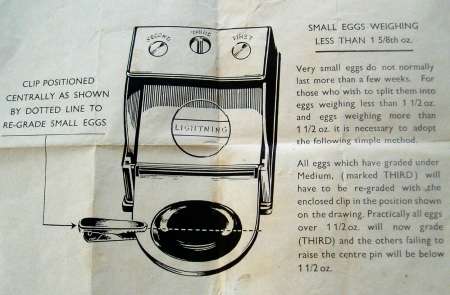
instruction sheet for use of the egg grader with the extra crocodile clip
|
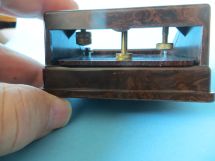
view on the three brass weights
|
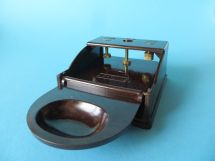
the egg grader
|
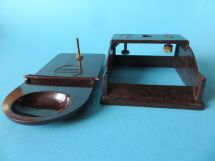
the two dismantled bakelite parts
|
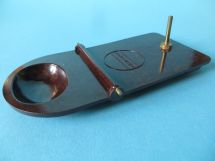
the seesaw with fixed brass shaft
|
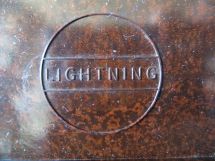
the LIGHTNING logo
|
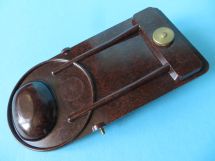
bottom of the seesaw
|
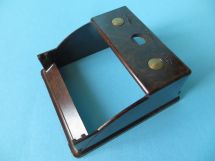
the housing part
|
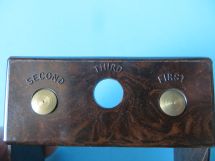
indication second - third - first
|
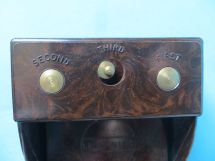
grader with seesaw assembled
|
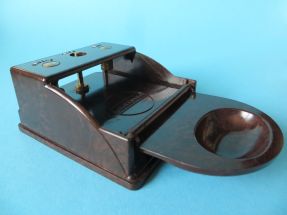
at rest the brass stem protrudes just through
the middle hole of the egg grader
|
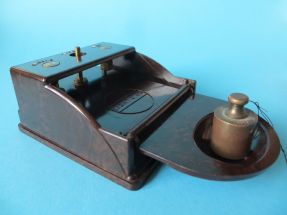
the left brass weight part is just not lifted
|
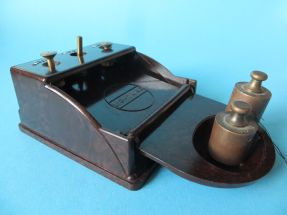
image like a heavy egg of the Large (= First) class
all three brass weight parts are lifted
|






















